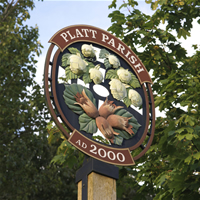
Potash Farm is situated at the southern end of the St Mary's Platt, which was originally part of the older Wrotham parish. The weathervane on top of the St Mary's Platt church tower is dated 1846. Beside the church steps is the millennium sign that features cobnuts and hops, that were widely grown throughout this parish and surrounding West Kent area. Alexander Hunt has lived in the village for 50 years and his parents moved to Platt in 1950.
The Potash Farm Plantation extends to about 6 acres and is likely to have been planted in about 1900. The plantation has been beautifully restored over the last five years and now contains about 500 original trees and 500 newly planted trees.
The whole purpose of the restoration of Potash Farm Plantation is to preserve the plantation as a fine example of cobnut growing in a village that derives its name from cobnut production. Alexander Hunt says "The plantation is today part of the village's heritage and having lived here all my life I feel this is part of the village and me".
Alexander Hunt has been involved with the Potash Farm Plantation for about twenty-five years, having recently purchased the plantation from a distant cousin of the Wolfe family.
To assist in the restoration there has been some support and grant aid from the Kent Downs AONB unit and the Medway Valley Countryside Partnership. The hedges are of a mixed nature including hazel, blackthorn, hawthorn, beach, holly, oak and ash. The plantation has been re-fenced using organic chestnut spiles, pig-wire and barbed wire. It may be that at a point in the future the plantation is grazed with a rare bread of sheep etc or poultry.

Throughout the plantation a wide range of birds and mammals are seen throughout the year including doormice, song thrushes, woodpeckers, tits, tree creapers, nuthatches, robins, pheasants, partridge, wrens and gold crests. The hedges are only pruned in late winter to allow the birds to eat the hips and haws. There are fox earths and badger sets, and grey squirrels are rampant but fortunately as the plantation is on two sides bordered by lanes, the traffic keeps the squirrels away from eating the majority of the cobnuts.
There are milkmaids, buttercups, snowdrops, speedwell, primroses, arum lily and sages on the floor of the plantation.
Today the whole of the crop is sold at Farmers Markets, select farm shops and London outlets including The Whole Foods Market in Kensington. The Jewish and Muslim communities buy many of the cobnuts during their festivals in October and September, such as Yom Kippur. The cobnuts are sold between mid August and mid June.
The maintenance of the plantation throughout the year is kept to a minimum with mowing about four to five times a year. The by-products of the plantation, such as hazel sticks and wands are used as bean poles and in gardens locally.
Alexander Hunt is a former Chairman of the Kentish Cobnuts Association which has about 175 members from Australia, California to St Mary's Platt.